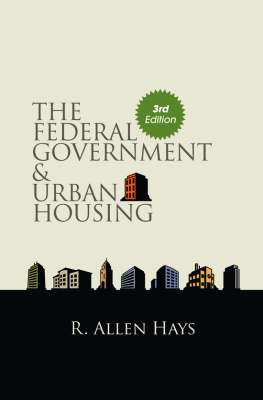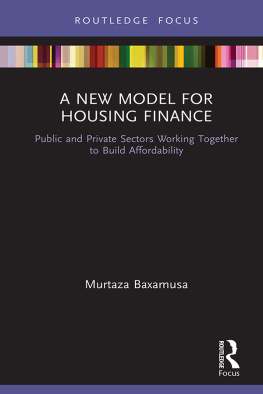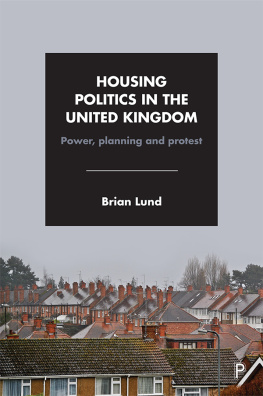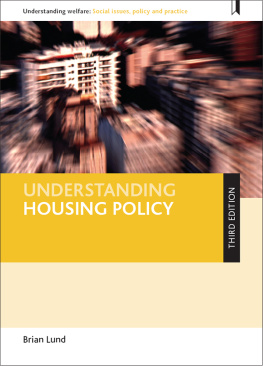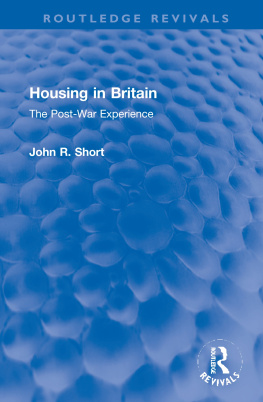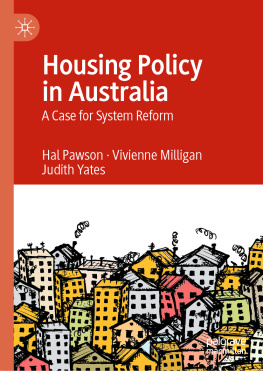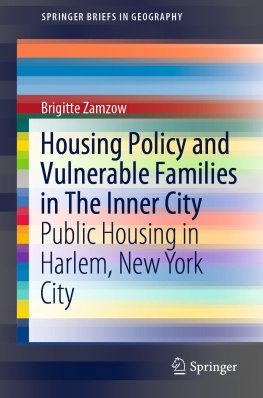Published by State University of New York Press, Albany
2012 State University of New York
All rights reserved
Printed in the United States of America
No part of this book may be used or reproduced in any manner whatsoever without written permission. No part of this book may be stored in a retrieval system or transmitted in any form or by any means including electronic, electrostatic, magnetic tape, mechanical, photocopying, recording, or otherwise without the prior permission in writing of the publisher.
For information, contact State University of New York Press, Albany, NY
www.sunypress.edu
Production by Ryan Morris
Marketing by Anne M. Valentine
Library of Congress Cataloging-in-Publication Data
Hays, R. Allen, 1945-
The federal government and urban housing / R. Allen Hays. 3rd ed.
p. cm. (SUNY series in urban public policy)
Includes bibliographical references and index.
ISBN 978-1-4384-4166-5 (pbk. : alk. paper) ISBN 978-1-4384-4167-2 (hardcover : alk. paper)
1. Housing policyUnited StatesHistory. 2. HousingUnited StatesHistory. I. Title.
HD7293.H394 2012
363.5'80973dc23
2011018384
10 9 8 7 6 5 4 3 2 1
INTRODUCTION TO THE THIRD EDITION
When the first edition of this book was published in 1985, housing and community development policy in the United States had just passed through a period of turmoil and change. The decade of the 1970s began with a commitment to greatly increase the federal government's role in ensuring that all citizens had access to affordable housing, utilizing both public sector production and subsidized private sector production. The Fair Housing Act of 1968 was a big step toward guaranteeing that full and fair access to housing wouldn't be denied on the basis of race. It also began with major reforms in the community development process designed to increase the benefits and reduce the costs of redevelopment to the lower income citizens who had so often been callously displaced by urban renewal efforts.
Unfortunately, over the course of the next two decades, a great deal of the momentum toward addressing the housing needs of low and moderate income households was lost. Public housing came in for severe criticism and for serious cutbacks in production. Private subsidy programs also lost support. In both cases, the decline in support was due to a combination of disillusionment with the way these programs were being executed and a shift toward the right in the political climate, which encouraged the scaling back of virtually all Great Society efforts. Meanwhile, federal community development efforts were scaled back so that, even though they had a less destructive impact on poor neighborhoods, they had less capacity to transform declining central cities. In addition, HUD lacked both the political will and the enforcement tools to overcome the tremendous inertia and resistance that perpetuated housing segregation based on race. From the perspective of the early 1980s, it seemed that the nation might virtually abandon any serious national efforts to address housing inequality and deprivation.
Now, looking back from the perspective of twenty-five years later, it is apparent that neither total recommitment to nor total abandonment of federal housing and community development efforts has occurred. In terms of the number of low to moderate income units produced or subsidized by the federal government, the level of effort displayed in the 1970s was never restored. The chief mechanism of assistance shifted from direct subsidies for housing production to vouchers that subsidized the consumer's purchase of housing services, but even these new subsidy mechanisms were funded at much lower levels than the older ones. Moreover, a significant portion of the new vouchers issued had to be used to maintain assistance to families who were losing support under the older system. Production of new, affordable housing units was shifted almost entirely to state and local governments and to nonprofit providers, who received indirect federal subsidies through the tax system. Even though this retrenchment began under two Republican presidents, Richard Nixon and Ronald Reagan, Democratic presidents have shown little enthusiasm for reversing it when they have come into office.
Redevelopment of central business districts and central city neighborhoods was also turned over almost exclusively to state and local actors. Block grant funding and tax free industrial development bonds often provide critical gap financing for central city projects, but the bulk of the funds now come from private investors and state/local sources. Residential neighborhoods near the central city have followed one of two paths; either they have undergone gentrification as upper-middle-class families reoccupied parts of the central city or they have been left to experience further disinvestment and abandonment. Neither of these outcomes is favorable to their former low income residents.
However, in spite of the persistently weak commitment of the national government to addressing housing needs, one can take heart from the fact that many of the assisted units that were available in the early 1970s have either been maintained or converted to vouchers, with the result that net losses in this original assisted housing stock have been much more limited than was feared in the 1980s. A number of extreme proposals to abolish the federal effort came to naught in Congress, even when Republicans were in the majority. One can also take heart from the fact that hundreds of thousands of units of low to moderate income housing have been produced in communities throughout the nation, by packaging state and local assistance with the limited federal assistance that has been available. In all parts of the country, there are numerous community leaders who recognize that substandard housing can blight the entire community and that families who are forced to spend large percentages of their incomes on housing may encounter other problems as a result. A broad spectrum of political leaders has been unwilling to totally abandon low income families to the tender mercies of the private market as they seek adequate shelter.
This book was initially written with two purposes in mind. The first was to provide a comprehensive history of housing policy since the Great Depression, something that was lacking when it was first published. The second was to place housing policy in the context of the overall political process in the United States; that is, to show how struggles for power among those with different visions of how a democratic capitalist society should be run have affected the specific outcomes of housing policies and programs. These remain the two central purposes of the Third Edition.
The first two chapters set the stage by presenting a model of the public policy process in which competing ideologies play a central role in framing and resolving issues. The liberal and the conservative outlooks are really two variations on the central ideology of democratic capitalism, but they still diverge greatly in their visions of the proper working of the system. These outlooks have continued to evolve during the entire eighty year period covered by this book, but the basic polarity that they represent remains the same. Liberals believe that the state needs to play a more active role in regulating the economy and ameliorating social inequality, in order for the system to provide maximum benefits to all. Conservatives believe that the state's role should be less active, with minimal regulation of the private sector and minimal public redistribution of goods and services. This fundamental split remains, even though important cultural/religious elements have been added to both ends of the spectrum. In writing the first edition, I believed it was necessary to defend the central place of ideological conflict in my analysis, since so much public policy seemed to emerge in the realm of centrist consensus. However, ideological polarization within the American political system has increased so much during the last twenty years that its influence on public policy is glaringly obvious in the current era.

